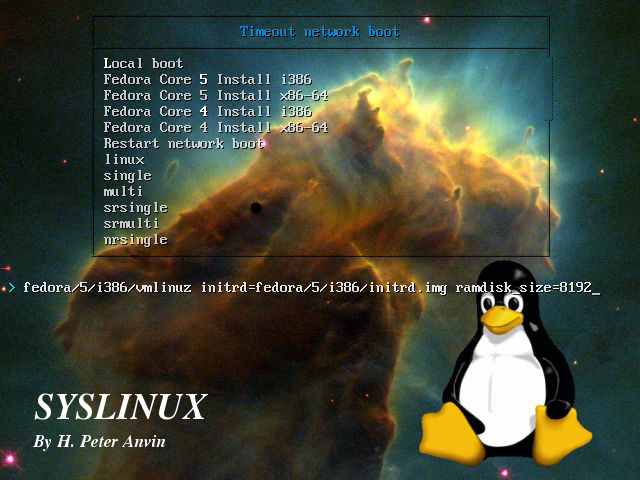SysLinux build boot disk
Installing syslinux on a disk will change the boot sector on the disk and copy the ldlinux.sys file to its root directory (or to a specified directory).
Note: SYSLINUX does not support NTFS file system, so the disk must be FAT (FAT16/FAT32) file system
NT/2K/XP
Syntax:
syslinux.exe [-sfmar][-d directory] <drive>: [bootsecfile]
For example:
Floppy: (a: is a floppy drive)
syslinux.exe a:
Hard disk/removable disk, etc.: (z: is the drive letter)
syslinux.exe -m -a -d /boot/syslinux z:
[Copy the boot file to the /boot/syslinux directory of its partition. Note: the /boot/syslinux directory must be created in advance. 】
*The boot menu configuration file (syslinux.cfg) in the above example must be in the /boot/syslinux directory. *Note: In NT/2K you may receive an error message, just select "Ignore" to complete the command correctly.
DOS
Syntax:
syslinux.exe [-sfmar][-d directory] <drive>: [bootsecfile]
Linux
Syntax:
syslinux [-sfr][-d directory][-o offset] <DeviceOrImage>
For example:
syslinux /dev/fd0
syslinux/devices/first floppy drive
[Write the syslinux boot code to the first floppy drive]
SysLinux related options
Applies to all
-s
Safe, slow, stupid: This parameter can improve the boot compatibility of syslinux. This parameter allows syslinux to work on some unconventional BIOS. The -s option (parameter) is required on some machines, which means that this is a safe option (parameter). It is recommended to generally use this option (parameter).
-f
Force installing: Force writing of syslinux boot code. This is an optional option (parameter). If you find that you cannot write to syslinux, you can use this option (parameter), but it is generally recommended to add this option (parameter) when writing to the local disk.
-r
Raid mode: RAID mode. This is an optional option (parameter). If the startup fails, tell the BIOS the boot sequence (usually the next hard disk) instead of giving an error message and then stopping. This is a RAID mode option (parameter) and generally can not be used.
Windows
-m
MBR: Write the syslinux boot code to the MBR boot sector of the drive. This is an optional option (parameter). It is recommended to use this option (parameter). If GURB4DOS has been written to the MBR of the disk before, then you must use the -m option (parameter), otherwise the write will fail.
I have written "grub for dos" into the MBR before, but when I write the syslinux boot code into the MBR later without using the -m option (parameter), I cannot write the syslinux boot code into the MBR.
Example: syslinux.exe -s -f -m -a -d /boot/syslinux x: (x: is the drive letter)
-a
Active: Activate the specified partition as the active partition. This is an optional option (parameter). You can add this option (parameter) when you are not sure whether the partition you specify is an active partition. In fact, you can add this option (parameter) even if the partition you specify is already an active primary partition. (=bootable)
Linux
-o
Specifies the byte offset in the file system image file, which must be a working disk image file.


































Useful
Useful
Useful